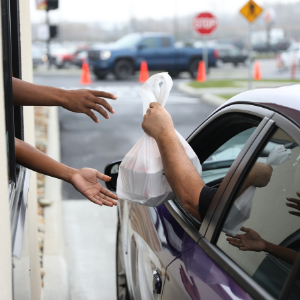Stats Of The Week
The State Of The Industry
With the future of the restaurant industry during the pandemic being unknown, staffing decisions have never been more difficult for restaurant operators. They must consider uneven customer traffic during a challenging economy, unpredictable dining regulations, and potential spikes in COVID-19 in the fall. In a survey conducted by the National Restaurant Association, when asked about staffing plans over the next 30 days, 26% of operators said they plan to add employees while 25% said they plan to lay off or furlough employees. Positive staffing outlook is slightly optimistic for quick-service, fast-casual, and coffee and snack concepts. 33% of limited-service operators plan to add employees over the next 30 days while 14% expect to cut staff.
Drive-Thru Sales Continue To Rise During Dining Room Closures
In the April, May, and June quarter, drive-thru visits increased by 26% and accounted for 42% of all restaurant visits during that time, according to new research from The NPD Group. Even though more dining rooms began to open in July, drive-thru visits still increased by 13% which is the highest visit increase among service channels including on-premises, carry out, and delivery. The continued rise of drive-thru operations is good news for the quick-service segment which garners 60-70% of its business through this channel.
"Fast-casual and traditional quick-service chains have already announced expansion plans for their drive-thru operations, and more chains will be doing the same. Drive-thru and other off-premises operations will be a major part of the U.S. restaurant industry’s recovery and future," David Portalatin, NPD food industry advisor, said in a release emailed to Restaurant Dive.
What’s Trending
Indoor Dining Returns To NYC
NY Governor Andrew Cuomo has announced plans for New York City to allow indoor dining beginning September 30. Since March, dining rooms have been shut down and will now resume at 25% capacity. Restaurants must also require temperature checks, one member of each party must provide contact information for tracing purposes, and restaurants must close at midnight. Bar services are still closed and masks must be worn at all times unless seated. New York has the highest amount of restaurants per capita and operators were growing restless to reopen. This lift on indoor operations will provide a much-needed boost to the city’s recovery and ends its status as one of the few places in the nation banning indoor dining. Gov. Cuomo said in a press conference on Wednesday that he credits the low infection rate to the state, less than 1%, to NY residents complying with local safety guidelines.
Third-Party Food Delivery Apps Launch Sponsored Restaurant Listings
Uber Eats has announced its first in-app advertising format to give restaurants a way to promote their menu offerings. In early tests, the food delivery service’s sponsored listings have seen a return on ad spend of five times, according to details Uber Eats emailed to Mobile Marketer. Their pricing model goes by cost-per-click so restaurants only pay when an app user clicks on the sponsored listing that appears at the top of the app’s home feed. Uber Eats has unveiled a self-serve ad platform that lets restaurants target their ads based on the location, order history, and dietary preferences of Uber Eats customers. To encourage restaurants to test the new service, the company is offering $25 million in marketing credits to small and medium-sized businesses that are facing challenges as pandemic lockdowns limit indoor dining.
Restaurateurs Scramble To Plan For Winter
In these unpredictable times during the pandemic, restaurants are planning for the worst case scenario for the upcoming winter months. Many states have restricted indoor dining which has resulted in restaurants depending on outdoor seating to stay afloat. Once the weather gets colder, that lifeline may not be an option for some. When it comes to planning for snowfall and cold temperatures, Julia Zhu, who is the managing partner at Bar Roma in Chicago, told CNN that she is trying to keep outdoor dining going as long as possible. That means looking into buying heaters for her patio and investing in coverings over tables. While most restaurants are still operating at a loss, these next few months will be yet another battle the restaurant industry will endure this year.
Fast-Casual Restaurants Pivot To Digital-Focused Models
During the pandemic, fast-casual restaurants have seen an uptick in drive-thru sales with customers feeling comfortable using that channel to limit human-to-human contact. Operators are taking advantage of this opportunity and planning to the future with new technologies to advance their contactless services. For example, Burger King has announced two new restaurant designs that will be dedicated to mobile order and curbside pickup areas, drive-in and walk-up order areas, and enhanced drive-thrus. These new concepts claim to be 100% touchless and 60% smaller than a traditional restaurant. Also, Dunkin’ is testing an Amazon Go-style store in California which allows customers to walk into a store to grab coffee and baked goods without interacting with anyone or scanning at a kiosk.
Large Chains Try Out Virtual Restaurants
As many restaurants try to bring in as much profit as possible during the pandemic, a growing number of
chains have added virtual kitchens to their existing chain restaurants. Outback Steakhouse is testing
out a new virtual kitchen concept called Tender Shack. About a dozen of the company’s units have started
offering fried chicken tenders and fries. The platters and sandwiches are sold only for delivery via
DoorDash. Chili’s has also established a virtual kitchen in 1,000 of their brick-and-mortar restaurants
called It’s Just Wings. It’s a wing-focused concept and is only available online or on DoorDash. The
list of chains affiliated with virtual restaurants includes Applebee’s, Smokey Bones, Fat Burger, and
Chuck E. Cheese.
Bright Spots In A COVID-19 World
Chef Turns Closed Restaurant Into A New Opportunity
Millie Peartree, owner and executive chef of MP Fish Fry & Soul Food in the Bronx, New York, is one of many chefs that has closed her doors indefinitely during the pandemic. She was determined to keep as many employees as possible to help her pivot to a new business model. Peartree launched Full Heart Full Bellies in April as a way to provide prepared meals for those impacted by the pandemic. The group shifted to feeding Bronx children in need of food with each child receiving one hot meal at least three times a week during the summer. With the help of her team, Peartree prepares comforting meals consisting of six ounces of lean protein, four ounces of fresh vegetables, and four ounces of starch.
They have received support from Audi, Amazon, Coca-Cola, and local restaurants and bakeries in the form of donated cars, kitchen space, and food and beverages. "[My] goal is to feed children and their families for an entire school year, providing 250,000 meals over 10 months," Peartree told TODAY.
Locals Work Together To Save Beloved Diner
Six months into the pandemic, Vicki’s Diner in Westfield, NJ was on the brink of permanently closing after its owners depleted their savings to pay their staff and cover expenses. Then, community organizers stepped in to save one of the town’s most popular diners. Locals came together and created a GoFundMe page for the 21-year-old diner. Nearly 250 people have donated to the campaign and reached more than $22,000 to help fund the diner and keep it open.
“We are very grateful. I feel overwhelmingly what we mean to the community,” Peter Rentoulis, co-owner of Vicki’s Diner, said to NJ.com. “Between the outside and inside [dining] and the funds, it will bring us to a safe level. We will make it through.”
Quote Of Hope
“Let’s not wait for the new normal, or hope for things to return to that of the past, but let’s start building our future.” - Kevin Lieu, chef and owner of GAI in San Francisco, CA








